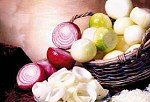Have you ever wondered why most culinary terms are French? French chefs were very skilled. When the French Revolution started and everyone was losing their heads, the chefs to the Royal Families decided that now was a good time to travel to distant places. The chefs took their skills and culinary terms all over the world. French became the standard language of cooking.
Whether you are from the U.S. or Outer Mongolia, you both know that mirepoix is the sautéed combination of onions, celery and carrots. Let’s start with some basics.
Stocks
Stocks are the foundation of cooking. (fond de cruisine). They add background to your dishes. Stock is made by simmering fresh bones in clear water. At the last hour, you may add meat or vegetables or both to the bones along with aromatics (seasonings and herbs – traditionally, peppercorns, thyme, parsley stems and bay leaves) and mirepoix. If you want a brown stock, add roasted tomato paste. Tomato paste is roasted to caramelize its sugars and break down the acids.
Mirepoix has a ratio of 50% onions, 25% carrots and 25% celery (2:1:1).
Start with a large stock pot (a pot taller than it is wide), add your bones and cover with water (the water should not be more than 2 inches over the bones). Bring slowly to a simmer. The bones will release impurities into the water, which will rise to the top as foam. Skim the foam (depouiller) to remove these from the stock. Removing the foam will make your stock clearer. The clearer the stock, the longer shelf life it will have. If you simmer the pot slightly off-center of the burner, the fat and impurities will gather along the edge of the pot away from the heat. Taste the stock every so often to find the peak flavor (if you simmer it too long, it becomes flat). Remove the stock from the heat and taste for seasoning. Add any more seasonings that you need while the stock is still warm. To strain the stock, set up a fine wire-mesh strainer (you can also use a colander lined with cheesecloth) over another pot or metal bowl and ladle the stock into it. If you are not going to use the stock right away, place the pot into a ice bath to cool. You can refrigerate or freeze your stock. When you are ready to use the stock, lift off any fat that is collected on top.
Cooking is an art, not a science. You do not have to rely on recipes if you understand the concept of cooking.
Tuesday, July 10, 2007
Subscribe to:
Post Comments (Atom)

 My StumbleUpon Page
My StumbleUpon Page
No comments:
Post a Comment